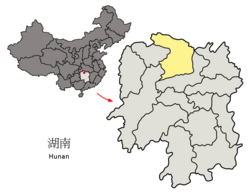Changde
常德市 Changte; Changteh | |
|---|---|
 | |
 Location of Changde jurisdiction in Hunan | |
| Coordinates (Changde municipal government): 29°01′52″N 111°41′56″E / 29.031°N 111.699°E | |
| Country | People's Republic of China |
| Province | Hunan |
| Municipal seat | Wuling District |
| Government | |
| • Mayor | Zhou Derui (周德睿) |
| • Party Secretary | Wang Qun (王群) |
| Area | |
| 18,177 km2 (7,018 sq mi) | |
| • Urban | 2,752 km2 (1,063 sq mi) |
| • Metro | 2,752 km2 (1,063 sq mi) |
| Elevation | 35 m (115 ft) |
| Population (2020 census)[1] | |
| 5,279,102 | |
| • Density | 290/km2 (750/sq mi) |
| • Urban | 1,469,055 |
| • Urban density | 530/km2 (1,400/sq mi) |
| • Metro | 1,469,055 |
| • Metro density | 530/km2 (1,400/sq mi) |
| GDP[2] | |
| • Prefecture-level city | CN¥ 427.5 billion US$ 63.4 billion |
| • Per capita | CN¥ 80,980 US$ 12,042 |
| Time zone | UTC+8 (China Standard) |
| Postal code | 415000 |
| Area code | 0736 |
| ISO 3166 code | CN-HN-07 |
| License plate | 湘J |
| City tree | Camphor laurel |
| City flower | Gardenia |
| Website | eng |
Changde (Chinese: 常德; pinyin: Chángdé; traditional Chinese: 常德區 [ʈʂʰǎŋ.tɤ̌]) is a prefecture-level city in the northwest of Hunan province, People's Republic of China. In addition to the urban districts, Changde also administers the county-level city of Jinshi and six counties. Changde is adjacent to Dongting Lake to the east, the city of Yiyang to the south, Wuling and Xuefeng Mountains to the west, and Hubei province to the north.[3]
The area has been inhabited by humans since around 8,000 years ago. In that time, the city has changed names several times, but it has been known as Changde since the 12th century. The city is well known for the Battle of Changde during the Second Sino-Japanese War (1937–45) and the atrocities committed then by the Imperial Japanese Army.
In the past decade, the city has seen a massive construction boom. New highrises have sprung up, roads were rebuilt and new schools, parks and museums have opened. Locals and tourists often visit the Changde Poetry Wall, covered in a variety of poems mostly from ancient China. The wall stretches for 3 kilometres (1.9 mi) along the Yuan River downtown and functions as a flood wall. It is listed in the Guinness Book of World Records as the longest wall with engraved arts in the world.[4]
- ^ "China: Húnán (Prefectures, Cities, Districts and Counties) - Population Statistics, Charts and Map".
- ^ "2022年湖南省各市州地区生产总值(三季度".
- ^ "Introduction to Changde". Changde(China) Official Web Portal- Changde's International Window. Changde City Government. Archived from the original on 13 December 2013. Retrieved 7 December 2013.
- ^ "Changde Poem Wall". China Daily. 2004-06-08. Retrieved 12 December 2013.
